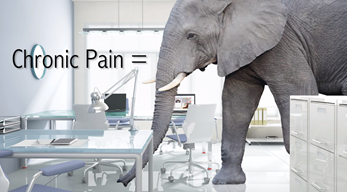The big elephant in the room of health care

Chronic pain conditions are the most prevalent chronic conditions and the primary driver of health care, costing more the diabetes, cancer, and heart disease combined.1-6 With at least 120 million U.S. adults suffering from chronic pain, it has become the primary reason for seeking health care, with over half of all visits attributed to some type of chronic pain. 4-5 Chronic pain is also the most common cause of disability and opioid dependency leading to more deaths than motor vehicle accidents in some states.11-14 Although the prevalence and cost burden of chronic pain are staggering, the personal cost of chronic pain can be even more devastating resulting in loss of function, disability, depression, suicide, addiction, and many other problems.6-10
Preventing chronic pain is overlooked

While major efforts are underway to prevent most other major health conditions, preventing chronic pain remains an enigma, overlooked by the public, neglected by the health care system, and generally ignored by the scientific community. Despite this societal and personal impact, the plight of the patient with chronic pain seeking health care is not encouraging. If initial efforts for improving pain fail, care often escalates to higher-cost higher-risk passive interventions such as on-going opioid analgesics, polypharmacy, implantable devices, injections, physical therapies, and surgeries.8-12 However, most people with chronic pain after 30 days still have pain 5 years later despite extensive passive treatments.14-16
Why is preventing chronic pain so difficult?
Most research suggest that the presence risk factors that are under more under patient’s control such as repetitive strain, depression, poor sleep, stress, maladaptive postures, and ergonomic factors are the major causes of delayed recovery and failed treatment. Despite that fact that these risk factors can be improved with self-management strategies, they are not often addressed in routine pain care resulting in pain persisting for years.13-18 Passive treatments such as medication, physical therapies, surgery and implants continue to be the dominant care strategy by health professionals since they are better reimbursed, easier to implement, and less time-consuming than teaching patients self-management skills. Thus, chronic pain has become the major health care problem primarily due to our lack of engaging, empowering, and educating patients in reducing the risk factors and enhancing the protective factors to prevent chronic pain.
Additional resources and websites:
2. Portenoy, R, Zeltzer. A Call to Revolutionize Chronic Pain Care in America: An Opportunity in Health Care Reform. MayDayFund, Nov. 4, 2009.
3. The Pain Action Alliance to Implement a National Strategy (PAINS) at http://www.painsproject.org
4. Center for Disease Control and Prevention (CDC), "Prescription Drug Overdose in the United States: Fact Sheet," http://www.cdc.gov/homeandrecreationalsafety/overdose/facts.html; C. M. Jones, K. A. Mack, and L. J. Paulozzi, "Pharmaceutical overdose deaths, United States, 2010," JAMA 309, no. 7 (2013).
5. Hestbaek L, Leboeuf-Yde C, Manniche C. Low-back pain: what is the long-term course? A review of studies of general patient populations. Eur Spine J 2003 Apr;12(2):149-65.
6. Deyo, RA; Mirza, SK; Turner, JA; Martin, BI (2009). "Over-treating chronic back pain: time to back off?". Journal of the American Board of Family Medicine: JABFM 22 (1): 62–8.
7. Bigos SJ, Battie MC. Risk factors for industrial back problems. Sem Spine Surg 1992;4:2-11
8. Turner JA, Holtzman S, Mancl L. Mediators, moderators, and predictors of therapeutic change in cognitive-behavioral therapy for chronic pain. Pain 2007;127(3):276-86.
9. Childs JD, Fritz JM, Flynn TW, et al. A clinical prediction rule to identify patients with low back pain most likely to benefit from spinal manipulation: a validation study. Ann Intern Med 2004;141:920-28.
10. Pincus T, Burton AK, Vogel S, Field AP. A systematic review of psychological factors as predictors of chronicity/disability in prospective cohorts of low back pain. Spine 2002;27:E109-20.
11. Turk DC, Okifuji A. Psychological factors in chronic pain: evolution and revolution. J Consult Clin Psychol 2002;70(3):678-90.
12. Coleman E, Parry C, Chalmers S, Min S. The Care Transitions Intervention: results of a randomized controlled trial. Arch Intern Med. 2006;166:1822-1828.
13. Foster G, Taylor SJC, Eldridge SE, Ramsay J, Griffiths CJ. Self-management education programmes by lay leaders for people with chronic conditions. Cochrane Database Syst Rev. 2007;17(4):CD005108.
14. Gensichen J, von Korff M, Peitz M, et al. Case management for depression by health care assistants in small primary care practices. Ann Intern Med. 2009;151:369-378.
15. Mansour M, Systems theory and human science (2002) Annual Reviews in Control, (26)1:1-13
16. Bailey B (2006). Living systems theory and social entropy theory. Systems Research and Behavioral Science, 22, 291-300.
17. Rolland JS Chronic Illness and the Life Cycle: A Conceptual Framework. Fam Proc 26:203-221, 1987
18. Dym D. The Cybernetics of Physical Illness. Family Process. 1987: 26(1) 35–48.

